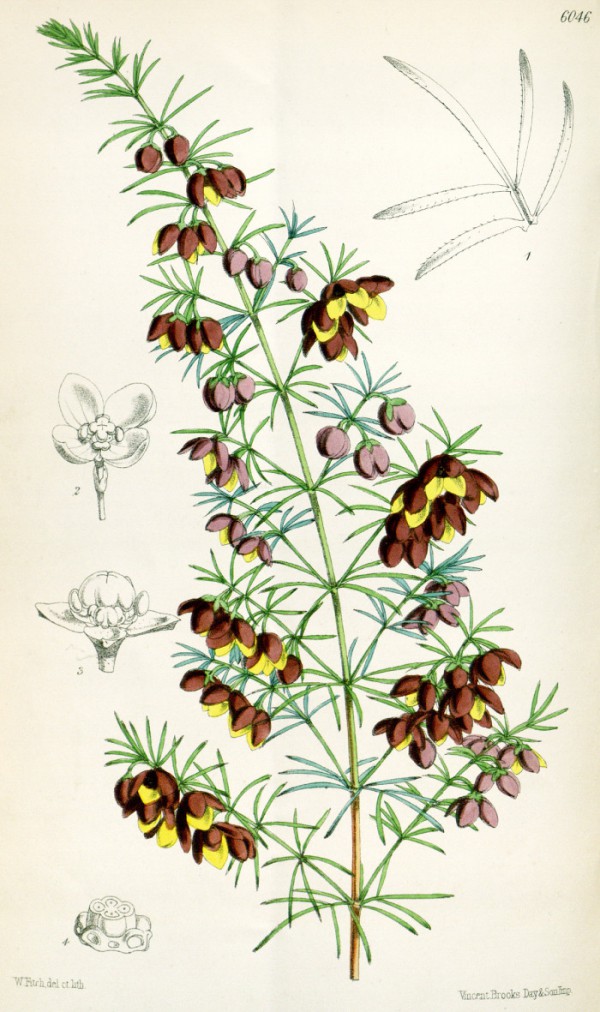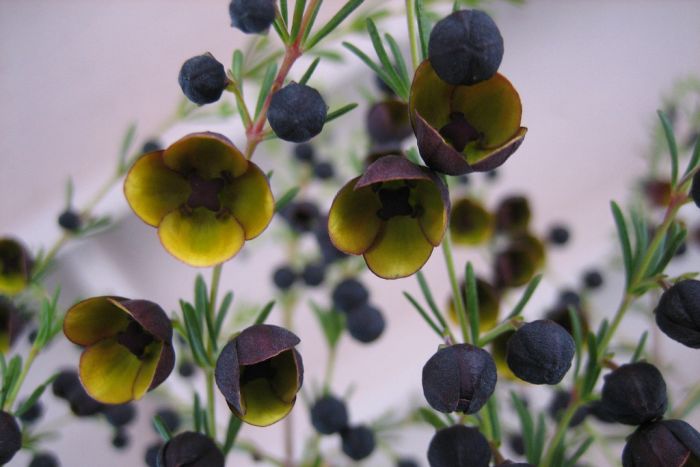Benutzer-Werkzeuge
Boronia megastigma Nees ex Bartl. - Rutaceae - brown boronia, scented boronia, Duftende Korallenraute, Boronia
Erect shrub, up to 2m tall, native to Western Asutralia, cultivated there; laeves linear, dark green, up to 1.5cm long; flowers dark reddish-purple to brown externally and bright yellow inside.
http://florabase.dpaw.wa.gov.au/browse/profile/4428
„B.megastigma is a small shrub which rarely exceeds a metre in height. It has small leaves which are also aromatic and small cup-shaped flowers which occur in the leaf axils in spring. The flowers are about 80-100 mm diameter. In the normal form of this plant, the exterior of the petals is a deep chocolate-brown in colour while the interior is bright yellow. A number of cultivars have been selected which have more attractively coloured flowers while retaining the fragrance. These include: Lutea - yellow both internally and externally; Chandleri - burgundy-red on the outside, yellow inside; Harlequin - striped yellow and brown on the outside, yellow inside.“
http://anpsa.org.au/b-meg.html
„For flavor and fragrance use, the flowers of Boronia megastigma are collected, extracted with petroleum ether (a hydrocarbon fraction), concentrated into a waxy concentrate (a concrete) and then the concrete is re-extracted with alcohol, and concentrated to form Boronia absolute. The absolute is typically a dark green semi-fluid liquid that possesses a fruity, tea-like, slightly herbaceous odor. In perfumes, boronia is used in violet, mimosa and honeysuckle bases, while for flavors it adds body and naturalness to flavors such as raspberry, strawberry, peach, etc.“
http://www.leffingwell.com/boronia.htm
„The petal waxes clearly contribute the bulk of the weight of the concrete from Boronia flowers, and the C17 to C33 saturated branched and linear hydrocarbons represent the proportion of these waxes amenable to GC analysis.“
Volatiles of the fraction to C20 (representing 16.0-25.9% of the concrete) were mainly α-pinene (2.3-11.0%), β-pinene (1.5-15.0%), limonene (1.0-2.7%), linalool (0.9-1.7%), β-ionone (11.9-22.5%), dodecyl acetate (5.6-11.1%), methyl jasmonate (3.4-7.2%), and (Z)-heptadec-8-ene (19.7-31.2%). Minor components included α-ionone, dihydro-β-ionone, 5,6-epoxy ionone, tetrahydroionone, and isoamyl salicylate e.g.
[Davies, N. W., and R. C. Menary. „Volatile constituents of Boronia megastigma flowers.“ Perfumer and flavorist 8 (1983): 3-8] https://core.ac.uk/download/pdf/33330178.pdf#page=222
Constituents of the absolute of B.megastigma from Tasmania were β-ionone and many of its derivatives like 7,8-dihydro-β-ionone, 7,8-dihydro-β-ionol, 4-oxo-β-ionone, 4-hydroxy-β-ionone, 4-oxo-β-ionol, and 3-hydroxy-β-ionone as well as isomeric 3-hydroxymegastigm-7-en-9-ones and megastigm-7-ene-3,9-dione. Furthermore, methyl (Z,E)-4-(geranyloxy)cinnamates, methyl (Z,E)-4-(5-hydroxy-geranyloxy)-cinnamates, alkyl esters of 8-hydroxylinalool, and N-[2-(4-prenyloxyphenyl)ethyl]tiglamide were identified.
[Megastigmanes and other constituents of the absolute of Boronia megastigma from Tasmania., Weyerstahl, P., Marschall, H., Bork, W.R., Rilk, R., Liebigs Annalen der Chemie, 1994(10), 1043-1047]
[Constituents of the absolute of Boronia megastigma Nees. from Tasmania., Weyerstahl, P., Marschall, H., Bork, W.R., Rilk, R., Schneider, S., Wahlburg, H.C., Flavour and fragrance journal, 10(5), 1995, 297-311]
In freshly open flowers, principle components were β-ionone (115-1092µg per g f.w.), dodecyl acetate (112-631µg), α-pinene (0-138µg) and β-pinene (0-109µg). Ethanolic extracts of petals and stigmas containing mostly β-ionone, dodecyl acetate and (Z)-heptadec-8-ene, whereas ovaries providing mostly α-pinene and β-pinene.
[Flower and volatile oil ontogeny in Boronia megastigma., Bussell, B.M., Considine, J.A., Spadek, Z.E., Annals of Botany, 76(5), 1995, 457-463] http://aob.oxfordjournals.org/content/76/5/457.full.pdf
„Essential oils are extracted from the flowers with hexane to yield about 0.4%-0.8% concrete. Concrete is washed with alcohol or distilled to yield 60% boronia absolute… It can be used in perfumes, cosmetics, and as a food flavoring where it enhances most fruit essences… ß-Ionone was the major essential oil component, followed by dodecyl acetate. α-Pinene and limonene were often present in similar quantities, and ß-pinene was usually the least abundant of the oil components examined. The mean quantity of oil components varied considerably between populations. α-pinene, ß-pinene and limonene were commonly absent from individual plants, but each of these compounds was present in at least one plant in each population. Location had some influence on the content of the monoterpene hydrocarbons. Southeastern populations had quite high concentrations of α-pinene, ß-pinene, and limonene, while northern populations all had low concentrations.“
[Selection of Boronia for essential oils and cut flowers., Plummer, J.A., J.M. Wann, J.A. Considine, and Z.E. Spadek., 1996, 602-609. In: J. Janick (ed.), Progress in new crops. ASHS Press, Arlington, VA. ] https://www.hort.purdue.edu/newcrop/proceedings1996/v3-602.html
„Boronia megastigma Nees. (brown boronia, family Rutaceae) is an endemic shrub grown commercially in Tasmania for production of a highly valued floral extract. The strongly perfumed red-brown and golden boronia flowers are harvested in September. A yellow-brown waxy concrete is extracted from the flowers to yield between 0.3
and 0.7% (by fresh flower weight) of extract, from which a viscous golden-coloured absolute may be prepared. Boronia extract has been fully described (Guenther, 1974 ; Davies and Menary, 1983 ; Weyerstahl et al., 1994);
β-ionone is the major volatile (12.30% of total volatiles in the extract). Boronia extract has an odour that is `powerful and characteristic; it recalls that of chopped spinach and blackcurrant buds, and after partial evaporation, like that of clove buds and infusion of tea' (Penfold and Phillips, 1927). Boronia absolute has an intense floral impact, its odour is reminiscent of cassis and violet. It has a natural fruity-green freshness entwined with the character of ripening hay and sweet tea; undertones of yellow freesias
and raspberries emerge before finishing with a slightly spicy-herbaceous (cinnamon and tobacco leaf), woody dry-out (Guenther, 1974; Roberts, 1984; Weyerstahl et al., 1994)… β-ionone, dodecyl acetate and (Z)-heptadec-8-ene occurred in extract from all five develelopment stages…“
[The Effect of Flower Maturity and Harvest Timing on Floral Extract fromBoronia megastigma (Nees)., Mactavish, H.S., Menary, R.C., Annals of Botany, 80(3), 1997, 299-303] http://aob.oxfordjournals.org/content/80/3/299.full.pdf
„While aroma constituents formed from carotenoids are perhaps the most important to the aroma of boronia, the absolute also contains a number of linalool related materials (linalool, linalyl acetate and a series of 8-hydroxylinalool esters) and compounds in the methyl jasmonate series… that undoubtedly impact the odor profile substantially.“
[Boronia, A Review by John C. Leffingwell, Leffingwell Reports, Vol.2 (No.4), October, 2002] http://www.leffingwell.com/boronia.htm

Curtis’s Botanical Magazine, vol.99 [ser.3, vol.29] t.6046 (1873) [W.H.Fitch]
http://plantgenera.org/species.php?id_species=150942

Boronia megastigma (labelled as: 'Jack Maguire's Red'); author: Eric Lux/ Flickr CC BY-SA 2.0
https://www.abc.net.au/news/rural/2015-01-23/boronia-megastigma/6041064
